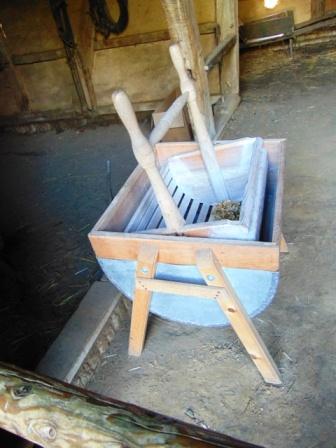Soap is formed by the saponification of a fat (or oil) with sodium hydroxide, optionally seasoned with odoriferous substances.
Soap is a surface - active substance thatcan easily reduce the surface tension of a liquid and forms foam and keeps dirt particles floating in water.
Soap also breaks the natural oily protective layer of the skin. This fat will be replenished by the sebaceous glands, but in the meantime, the skin is less protected against outside influences. The skin is temporarily more sensitive to irritant substances and feels dry.
 Soap is made from vegetable or animal fat (triglycerides) reacting with a strong base, nowadays usually sodium hydroxide (NaOH) (caustic soda or drain cleaner!) or potassium hydroxide (KOH), formerly potash. This process works better as the potassium (or sodium) carbonate first is converted with slaked lime (calcium hydroxide) to KOH (or NaOH). The mixture is cooked together in the correct proportions (the soap seething) until free base and un- saponificated fats are no longer present. Then the soap is made insoluble by adding salt so she flocculates. The soap flakes floating on top of the lower leach, where the bulk of the released glycerin is in. After several purification steps both in the crude but fairly pure form can be extracted separately.
Soap is made from vegetable or animal fat (triglycerides) reacting with a strong base, nowadays usually sodium hydroxide (NaOH) (caustic soda or drain cleaner!) or potassium hydroxide (KOH), formerly potash. This process works better as the potassium (or sodium) carbonate first is converted with slaked lime (calcium hydroxide) to KOH (or NaOH). The mixture is cooked together in the correct proportions (the soap seething) until free base and un- saponificated fats are no longer present. Then the soap is made insoluble by adding salt so she flocculates. The soap flakes floating on top of the lower leach, where the bulk of the released glycerin is in. After several purification steps both in the crude but fairly pure form can be extracted separately.
The Babylonians made already soap around 2,800 BC. Soap molecules have a long, fatty tail and an electric (hydrophilic) loaded head. They form small spheres or micelles in water with the water-repellent (hydrophobic) tails inward. These balls are by their fat not soluble in water, but keep dirt stuck, so that it can be washed away.
Sodium salts give a hard, and potassium salts a mild soap. Calcium - and magnesium salts to give foam.
"Tomorrow thereare vaccinations, so wash your arms! " "Which, the left or the right?" (JW Besouw)
Sebum (L: sebum) refers to a fatty substance that is produced by the sebaceous glands in hair roots in the dermis. This sebum keeps the hair and epidermis supple and protects against dehydration and infection by bacteria and fungi. Sebum consists mainly of fatty acid and esters and is odorless, but bacteria can give it a characteristic odor. Sebum production is dependent on hormonal and age. Too much sebum leads to acne.
The clay mineral talc is a hydrated magnesium - hydrogen -containing silicate having the chemical formula H2Mg3(SiO3)4 or Mg3Si4O10(OH)2 . It arises from the weathering of silicates of magnesium. The platelet-like to needle-shaped mass is a very soft mineral (hardness 1) and feels soapy or greasy. It has an average density of 2.75 and is in a purified form translucent.
As soapstone it is used to cut figurines.
And as stove shell. It can store over a longer period extreme warmth and release it very slowly again.
